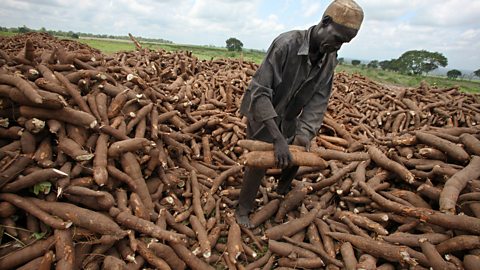Case study - increasing food security - Ghana
Ghana is an emerging and developing country (EDC)A country that has some aspects of a developed country but does not meet the required standards to be an advanced country. located in western Africa with a rapidly increasing population. In 2008 it was 23 million and in 2013 it had risen to 26 million. The country has lots of fertile land, but still suffers from food insecurityWhen people do not have enough nutritious and affordable food to eat..
About 5% of Ghana's population (1.5 million people) suffer from food insecurity, and another 2 million people are vulnerable to food insecurity. Their consumption is barely adequate and would soon disappear with a climatic or physical hazard shockA sudden event or phenomena that creates danger for people..
Ghana has a food deficit - in 2007 it was 59 kilocalories per person per day, but by 2012 it was down to 22 kilocalories per person per day.
The number of people who are undernourished went down from 2.8 million in 2007, to 1.2 million by 2012.
Ghana has put measures in place to increase food supplies.
Case study: large-scale irrigation agriculture
In Ghana the percentage of farmland equipped for irrigationThe channelling of water from rivers and streams to fields in order to help crops grow. is just 0.01% of the arable land. This figure has not changed since 2008. There are 13 completed irrigation projects in Ghana covering 325 hectares.
Where water is in short supply, farmers can bring in water to increase their yields. The supplies are reliable and thus have positive economic and social benefits, eg less rural to urban migration. On the negative side, soils are leached and degraded, river and lake habitats are reduced, and underground water levels can be depleted.
The Kpong Irrigation project in Ghana covers 616 hectares of farmland about 100 km from Accra. Crops that can now be grown include aromatic rice, onions, chillies, carrots and okra. Water is brought from two catchments - the Volta and the coast because the project was built on the watershedThe place that divides two river basins..
There is more food being grown and farmers' incomes have risen. However, the canals have eroded and silted up because maintenance is expensive.
Local case study: urban farming in Accra, Ghana
urban farmingThe growing of crops in and around towns and cities. is a recent initiative, whereby residents grow food on patches of land near where they live or work. The scheme is sustainable, in that local people have control over decisions and the initiative is manageable.
About 1,000 people earn their living from small urban gardens in Accra. They are important in supporting food security in the city.
- The gardens provide fresh produce like lettuce, sweet potatoes and bananas depending on the season. Some gardens keep livestock like goats, chickens and a small rodent delicacy called a grasscutter.
- These gardens began in the 1970s after the government initiative Operation Feed Yourself. This has ended but the gardens continue, often worked by rural to urban migrants, who have little other work experience.
- The food is very fresh and accessible to the city residents with few food miles.
- It provides more choice and more food which improves health in the city.
- The gardens may use contaminated water for irrigation and there are no controls over the use of chemicals. The farmers have no security of tenure and little access to the credit that would see them expand or invest in seeds or equipment.
- Recently the University of Ghana and the NGO Enterprise Works launched Citiveg to support and advise the urban farmers, and the government is beginning to show support through its new Urban Policy.
National case study: the Green Revolution in Ghana
In 2012, Ghana signed up to a G8 initiative called the New Alliance for Food Security and Nutrition. They decided to focus on five crops: cowpea, maize, cassava, rice and yam. The government invested in 42 new High Yield Variety SeedsSeeds which can produce up to ten times more crops than regular seeds. (HYV) for their focus crops, plus others such as groundnut and soybean. They also introduced inorganic fertilisers, built grain warehouses and provided training for farmers.
Advantages
- 46,869 farmers have learned useful skills, such as warehouse management. This has allowed them to store crops in warehouses rather than homes and fewer crops become spoiled or contaminatedWhen something is unclean or in some cases toxic..
- 204,620 farmers are using the improved seed varieties. These are high-yielding crops so more food is being grown.
- Many farmers have increased their maize yields by up to 400%.
Disadvantages
- A new law (the Plant Breeders Bill) has been put in place to protect the companies that produce the high-yield variety crops. Farmers used to swap seeds, but this is now illegal and they have to pay for any new seeds.
- Inorganic fertilisers are too expensive and so some farmers cannot afford them.
- Those farmers who can afford the new fertilisers have sometimes used too much. This has caused pollution.

Ghana had previously attempted to achieve food security with the Green Revolution. In the 1960s and 1970s, the Green Revolution techniques in Asia and South America had years of success, with yields increasing up to three-fold. Farmers used new varieties of seed, and needed much fertiliser and irrigation.
When the same approaches were tried in Ghana, farmers did not see the same yield increases. Most of Ghana's farmers could not afford the seeds, or fertiliser and irrigation costs.
The recent Green Revolution projects in Ghana have support and financial funding from the government and non-governmental organisation (NGO)A company that does not work for the government, eg a charity.. The funding can help farmers to pay the ongoing costs of using genetically modified foodFood that has been grown from seeds which have been altered by science. and paying for the labour intensive technologies.